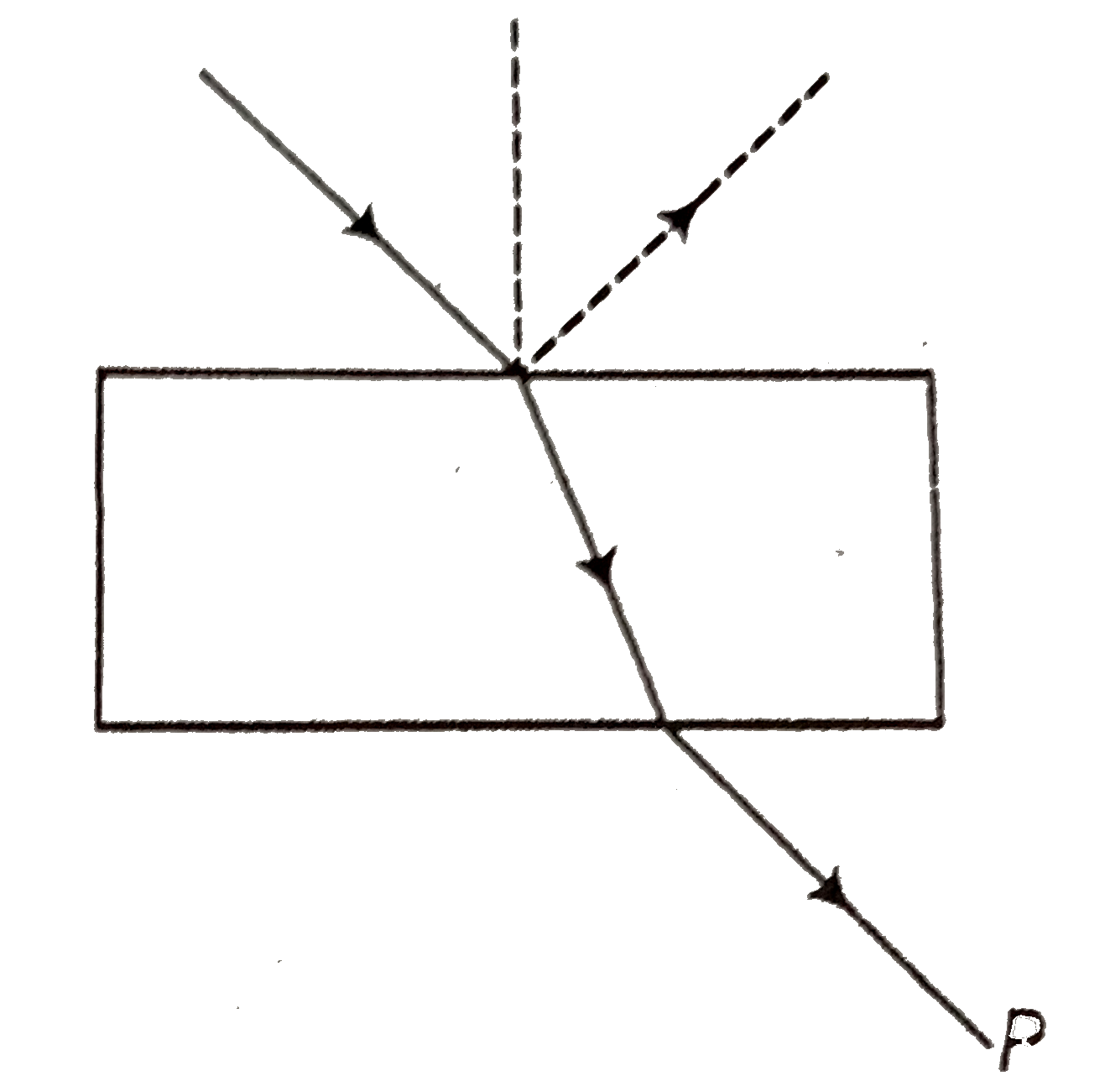A short pulse of white light is incident from air to a glass slab at normal incidence. After travelling through the slab, the first color to emerge is.
blue
green
violent
red
To solve the question of which color emerges first when a short pulse of white light travels through a glass slab at normal incidence, we can follow these steps:
1. Understanding White Light: White light is composed of multiple colors, which can be represented by the acronym VIBGYOR (Violet, Indigo, Blue, Green, Yellow, Orange, Red). Each color has a different wavelength.
2. Normal Incidence: When light strikes the glass slab at normal incidence, it does not change direction. This means that all colors enter the glass slab without bending.
3. Speed of Light in Different Mediums: In air, all colors of light travel at the same speed. However, when light enters a denser medium like glass, the speed of light changes depending on the wavelength of each color.
4. Wavelength and Velocity Relationship: The speed of light in a medium is inversely related to its wavelength. This means that colors with shorter wavelengths (like violet) travel slower in the glass than colors with longer wavelengths (like red).
5. Comparison of Speeds: Among the colors in white light:
- Violet has the shortest wavelength and travels the slowest in glass.
- Red has the longest wavelength and travels the fastest in glass.
6. Emergence of Colors: Since red light has the highest speed in the glass slab, it will emerge from the slab first when the light exits back into the air.
7. Conclusion: Therefore, the first color to emerge from the glass slab is red.
Final Answer:
The first color to emerge from the glass slab is red.
---
- Violet has the shortest wavelength and travels the slowest in glass.
- Red has the longest wavelength and travels the fastest in glass.
The first color to emerge from the glass slab is red.
Topper's Solved these Questions
- RAY OPTICS AND OPTICAL INSTRUMENTS BOOK - NCERT EXEMPLAR ENGLISHCHAPTER - RAY OPTICS AND OPTICAL INSTRUMENTS EXERCISE - MULTIPLE CHOICE QUESTIONS (MORE THAN ONE OPTIONS )
6 Videos
- RAY OPTICS AND OPTICAL INSTRUMENTS BOOK - NCERT EXEMPLAR ENGLISHCHAPTER - RAY OPTICS AND OPTICAL INSTRUMENTS EXERCISE - VERY SHORT ANSWER TYPE QUESTIONS
16 Videos
- NUCLEIBOOK - NCERT EXEMPLAR ENGLISHCHAPTER - NUCLEIEXERCISE - Long answer type question
10 Videos
- SEMICONDUCTOR ELECTRONICS: MATERIAL,DEVICES AND SIMPLE CIRCUITBOOK - NCERT EXEMPLAR ENGLISHCHAPTER - SEMICONDUCTOR ELECTRONICS: MATERIAL,DEVICES AND SIMPLE CIRCUITEXERCISE - Multiplel choice questions
26 Videos
Similar Questions
Knowledge Check
A short pulse of white light is incident from air to a glass slab at normal incidence. After travelling through the slab, the first colour to emerge is.
AblueBgreenCvioletDredWhite light is incident normally on a glass slab. Inside the glass slab,
Ared light travels faster than other coloursBviolet light travels faster than other coloursCyellow light travels faster than other coloursDall colours travels with the same speed.Consider a light beam incident from air to a glass slab at Brewster's angle as shown in figure.
A polaroid is placed in the path of the emergent ray at point P and rotated about an axis passing through the centre and pependicular to the plane of the plaroid.
 AFor a paricular orientation there shall be darkness as observed through the polaroid.BThe intensity of light as seen through the polaroid shall be independent of the rotation.CThe intensity of light as seen through the polaroid shall go through a minimum but not zero for two orientations of the polaroid.DThe intensity of light as seen through the polaroid shall go through a minimum for four orientations of the polaroid.
AFor a paricular orientation there shall be darkness as observed through the polaroid.BThe intensity of light as seen through the polaroid shall be independent of the rotation.CThe intensity of light as seen through the polaroid shall go through a minimum but not zero for two orientations of the polaroid.DThe intensity of light as seen through the polaroid shall go through a minimum for four orientations of the polaroid.
A ray of monochromatic light is incident from air on a glass slab.
Mark the lateral displacement in your diagram.
View SolutionA ray of monochromatic light is incident from air on a glass slab.
Name the two rays that are parallel to each other.
View SolutionA ray of light is incident on a glass slab at grazing incidence. The refractive index of the material of the slab is given by μ=√(1+y) . If the thickness of the slab is d=2m, determing the equation of the trajectory of the ray inside the slab and the coordinates of the point where the ray exits from the slab. Take the origin to be at the point of entry of the ray.
View SolutionConsider a light beam incident from air to a glass slab at Brewster's angle as shown in figure.
A polaroid is placed in the path of the emergent ray at point P and rotated about an axis passing through the centre and pependicular to the plane of the polaroid.

View SolutionConsider a light beam incident from air to a glass slab at Brewster's angle as shown in figure.
A polaroid is placed in the path of the emergent ray at point P and rotated about an axis passing through the centre and pependicular to the plane of the plaroid.

View Solution

